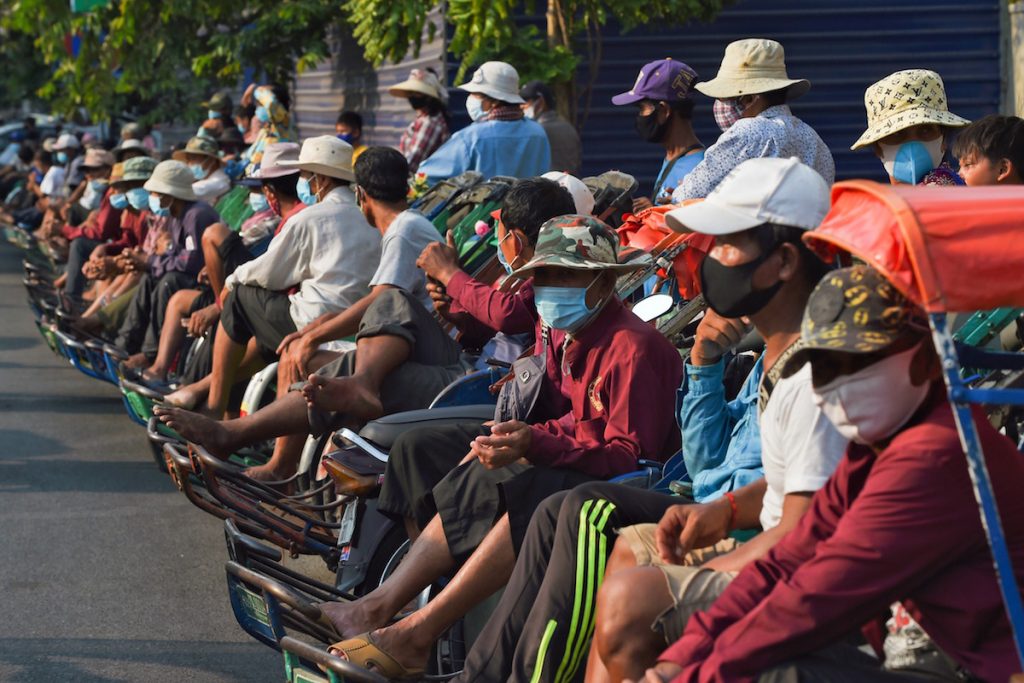When COVID-19 choked off the tourism that throttles Cambodia’s temple town of Siem Reap, Yu Thy and his wife lost their gardening jobs and headed home to grow something different.
They’ve not looked back.
For the switch from hotel gardeners to vegetable farmers has been a rare sliver of good fortune forced on them by a pandemic that has killed nearly 400 Cambodians.
A year after the couple packed up their Siem Reap life and travelled 300 km to their village, life has changed so much for the better they have no plans to go back.
At the root of the decision — a simple, 1.5-hectare plot allocated under a government-led program on which the couple now grow vegetables, tend rubber trees, and raise chickens.
As most Cambodians struggled to make a living in lockdown, Thy and his wife provided for their family and even made extra by selling their vegetables in central Tboung Khmum province.
Thy is his own boss and sets his own hours — his new life in rustic Chaem Kravien commune is a world away from Siem Reap, which throngs with visitors drawn to its world-famous Angkor Wat complex of Buddhist temples.
“We’re very glad that we had a house and land to come back to,” said Thy.
“If we didn’t have land, we would have been badly affected by COVID-19, and would have had to move from place to place selling our labor. We are happy to work on our own land.”
Thy, already earning well from his vegetables, now hopes to expand business by selling chickens and rubber, too.
He is among 250 formerly landless people, small landholders or indigenous people in Chaem Kravien who received a residential plot and farmland from the World Bank-backed Land Allocation for Social and Economic Development (LASED) project.
Since 2008, LASED has allocated about 17,000 hectares to some 5,000 families. More than 3,300 of them now have titles to their land with the rest set to join them after five years work.
“The goal of the LASED initiative is to fight poverty in a sustainable manner,” said Mudita Chamroeun from the World Bank, which has approved a new $93-million loan for the project.
Thy shows that schemes like this really work, she told the Thomson Reuters Foundation, adding: “This project has helped families weather the loss of jobs due to the COVID-19 pandemic.”

Land loss
Despite rapid urbanization, about three in four Cambodians live in rural areas, and most depend on land for a living.
Yet Cambodia has a long history of landlessness, with bloody conflicts over land common after the Khmer Rouge destroyed property records to establish a form of communism in the 1970s.
The impoverished Southeast Asian country began issuing Economic Land Concessions (ELC) in 1995, leasing state land to private firms for agriculture and agriculture-based industries to spur economic growth and alleviate poverty.
By 2012, ELCs accounted for more than 2 million hectares of land, equivalent to more than half the country’s arable land.
The land deals have displaced more than 770,000 people — mostly in rural areas — since 2000, human rights lawyers say.
A moratorium on new ELCs has been effective since 2012 and the government has conducted a review of ELCs, resulting in halving their area with an aim to redistribute the land and promote new forms of investment such as contract farming.
“What is needed to address the problem of landlessness is a much more ambitious land distribution program that acknowledges the central role that agriculture plays for a majority of the rural population,” said Jean-Christophe Diepart, a researcher at the Mekong Region Land Governance think tank.
‘Real’ land reform
The state owns about 80% of Cambodian land.
A law adopted in 2001 established a system for land titling and created a dispute-resolution system, followed in 2008 with a declaration that aimed to cut poverty, and improve food security and environmental protection.
The government had planned to register all land parcels in the country by 2021 to remove uncertainty over ownership and prevent conflicts, but the process is incomplete.
While programs such as LASED benefit small pockets of the population, “there is a need for real land reform,” said Eang Vuthy, executive director of Equitable Cambodia, a human rights organization in the capital Phnom Penh.
“Hundreds of thousands of families have been victimised by land grab across the country. And there is really no more free land to distribute,” he said.
Bolt hole in pandemic
Over the last year, nearly 50 families who had received land under the LASED project returned to their holdings after losing jobs in the cities or overseas, according to the World Bank.
Some, like Thy, say they will not return to their old jobs.
“To the extent that outmigration is driven by poverty, it is hoped that LASED can contribute to reduced outmigration,” said Chamroeun.
“However, it is too early to claim success, as the development … is a long-term endeavour,” she said.
For Yon Leng Sung, 30, and her husband Pha Sophon, who returned to her parents’ home in eastern Kratie province last year after losing their jobs as construction workers in Thailand – the decision is clear.
Leng Sung’s parents had received a residential plot and three hectares of farmland on which they grew cassava.
Leng Sung and her husband now help out so they can all expect a bigger harvest this year.
“We won’t go back to Thailand again after COVID-19,” she said. “My husband and I will stay here to look after the farm and take care of our parents.”
Reporting by Rina Chandran; Editing by Lyndsay Griffiths. Thomson Reuters Foundation